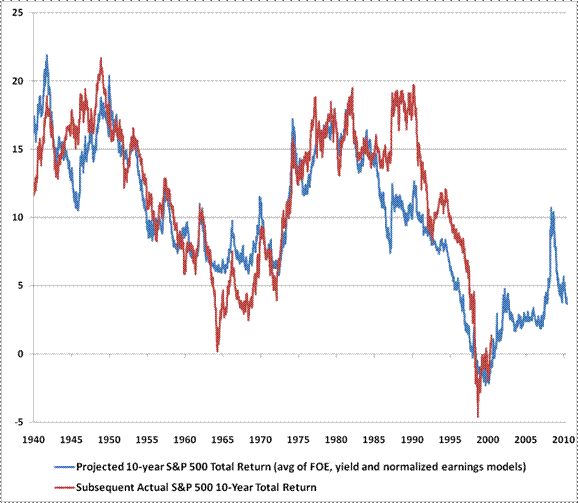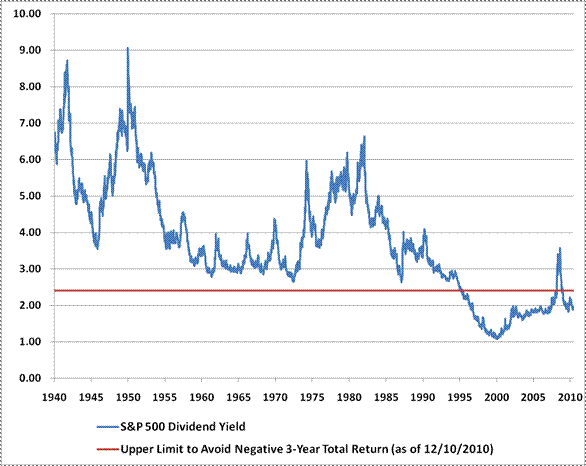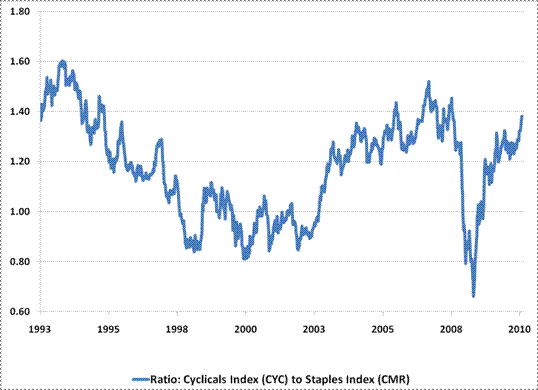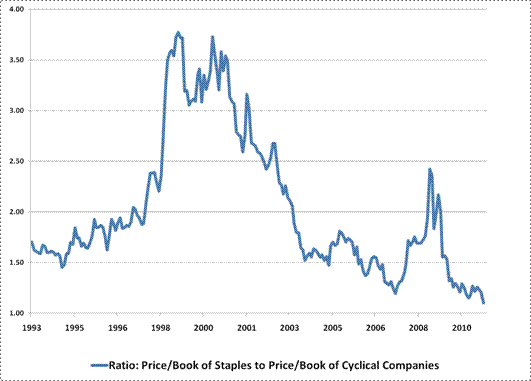Warning - An Updated Who's Who of Awful Times to Invest
John P. Hussman, Ph.D.
All rights reserved and actively enforced.
Reprint Policy
In recent weeks, the U.S. stock market has been characterized by an overvalued, overbought, overbullish, rising-yields syndrome that has historically been hostile to stocks. Last week, the situation became much more pointed. Past instances have been associated with such uniformly negative outcomes that the current situation has to be accompanied by the word "warning."
The following set of conditions is one way to capture the basic "overvalued, overbought, overbullish, rising-yields" syndrome:
1) S&P 500 more than 8% above its 52 week (exponential) average
2) S&P 500 more than 50% above its 4-year low
3) Shiller P/E greater than 18
4) 10-year Treasury yield higher than 6 months earlier
5) Advisory bullishness > 47%, with bearishness < 27% (Investor's Intelligence)
2) S&P 500 more than 50% above its 4-year low
3) Shiller P/E greater than 18
4) 10-year Treasury yield higher than 6 months earlier
5) Advisory bullishness > 47%, with bearishness < 27% (Investor's Intelligence)
[These are observationally equivalent to criteria I noted in the July 16, 2007 comment, A Who's Who of Awful Times to Invest. The Shiller P/E is used in place of the price/peak earnings ratio (as the latter can be corrupted when prior peak earnings reflect unusually elevated profit margins). Also, it's sufficient for the market to have advanced substantially from its 4-year low, regardless of whether that advance represents a 4-year high. I've added elevated bullish sentiment with a 20 point spread to capture the "overbullish" part of the syndrome, which doesn't change the set of warnings, but narrows the number of weeks at each peak to the most extreme observations].
The historical instances corresponding to these conditions are as follows:
December 1972 - January 1973 (followed by a 48% collapse over the next 21 months)
August - September 1987 (followed by a 34% plunge over the following 3 months)
July 1998 (followed abruptly by an 18% loss over the following 3 months)
July 1998 (followed abruptly by an 18% loss over the following 3 months)
July 1999 (followed by a 12% market loss over the next 3 months)
January 2000 (followed by a spike 10% loss over the next 6 weeks)
March 2000 (followed by a spike loss of 12% over 3 weeks, and a 49% loss into 2002)
March 2000 (followed by a spike loss of 12% over 3 weeks, and a 49% loss into 2002)
July 2007 (followed by a 57% market plunge over the following 21 months)
January 2010 (followed by a 7% "air pocket" loss over the next 4 weeks)
April 2010 (followed by a 17% market loss over the following 3 months)
December 2010
Since Investor's Intelligence data is not available prior to the mid-1960's, we get a few additional observations if we drop the "overbullish" criteria in prior years. These include December 1961 (followed by a 28% market loss over the following 6 months) and a few quick market plunges in the mid-1950's. I've excluded these in the list above because we don't have associated sentiment readings.
Since Investor's Intelligence data is not available prior to the mid-1960's, we get a few additional observations if we drop the "overbullish" criteria in prior years. These include December 1961 (followed by a 28% market loss over the following 6 months) and a few quick market plunges in the mid-1950's. I've excluded these in the list above because we don't have associated sentiment readings.
It's not pleasant to adhere to our discipline here, but I believe that it is essential to do so, because conditions like these are often where it matters most, despite the discomfort. We've lost several percent in the Growth Fund in an advancing market, reflecting a tendency of investors to abandon stable investments in preference for the "risk trade" in highly cyclical stocks, as well as option time decay in an environment where defense is seen as unnecessary. The market's recent embrace of the "risk trade" can be traced to the apparent endorsement of risk-taking by the Fed. Still, it's wise to remember that while Fed Chairmen have proven to be apt encouragers of bubbles over the short term, the "Greenspan put" certainly didn't avoid the 2000-2002 mauling, nor did the "Bernanke put" avoid the even deeper 2007-2009 plunge. The only put options that investors can rely on here are the contractual kind.
It's fair to criticize my inclusion of other post-credit crisis data in my evaluation of market conditions since 2009. While I didn't believe it was proper to use strictly post-war data when conditions were clearly "out of sample," it turns out that investors have approached the market as a "typical" post-war cycle, and been willing to overlook whatever underlying strains persist in the financial system. I suspect this is because FASB does not require mark-to-market reporting on the actual value of assets held by financial institutions, and because nobody cared when the Federal Reserve illegally acted outside of Section 14(b) of the Federal Reserve Act by purchasing $1.5 trillion of GSE debt that is a) not guaranteed as to principal and interest by the U.S. government, b) is not foreign government debt, and c) is not U.S. government agency debt. On this, note the distinction made in 2001 by William Poole, the head of the Federal Reserve Bank of St. Louis, in a paper entitled The Role of Government in US Capital Markets. Poole distinguishes GSEs such as Fannie Mae and Freddie Mac from "Ginnie Mae, the Veterans Administration, and the Federal Housing Authority, which are not GSEs but instead are agencies of the federal government carrying the full faith and credit of the government." In another paper, GSE Risks, Poole observes about Fannie and Freddie (F-F) that "although many investors assume that F-F obligations are effectively guaranteed by the U.S. government, the fact is that the guarantee is implicit only." I continue to believe that Fed purchases of GSE debt were in violation of the Federal Reserve Act, as were the Maiden Lane transactions. In any event, however, the integrity of the U.S. financial system is an open topic for debate, and there is not clear data by which to resolve the matter one way or another. My insistence on expanding the data set to other post-crisis periods has clearly not been helpful since 2009, and at least to this point, my concerns have been misplaced.
Still, it's important to recognize that our defensiveness here is unrelated to issues regarding credit or economic concerns. However one judges the inclusion of post-credit crisis data in our analysis (which kept us more defensive than was necessary, in hindsight, particularly during 2009 and early 2010), the fact is even discarding that data, our best post-war measures have been defensive since the April high, and dramatically so over the past several weeks.
Our concern about overvalued, overbought, overbullish, rising-yields conditions should be evaluated on the basis of the data regarding that syndrome of conditions, and this data is readily available. As noted above, the evidence is uniformly hostile. Importantly, the instances listed did not require a backdrop of unfavorable economic conditions. The average Purchasing Managers Index at the time of these market peaks was 58. The PMI was relatively stable, on average, over the following 3 months. The rate of new unemployment claims was typically near its 5-year average. By definition, stock prices were in an uptrend at the time. Overvalued, overbought, overbullish, rising-yield conditions are unfavorable in and of themselves. The present instance may turn out differently, but that expectation would be a clear outlier.
We certainly are aware of trend-following models that are positive here, but these things are testable, and when we do so, we find that they have performed less well over the long-term, and with much larger drawdowns, than our Market Climate approach (if that wasn't the case, we would be using them instead). As I noted in recent weeks, we've introduced robust modifications that broaden the number of Climates we define, and will allow us to take moderate, transitory exposure to market fluctuations much more frequently. So despite our present defensiveness, we expect to have more sensitivity to short and intermediate-term fluctuations as we move forward. Clearing the overbought and overbullish components of the present environment, without a significant breakdown in overall market internals, would be the quickest way to prompt a more constructive stance, even in what we view as an overvalued market. All of that said, we are hard defensive here.
How repurchases affect stock valuation
One of the elements of "common knowledge" among investors is that stock repurchases should be counted as "dividends" for the purpose of stock valuation. While the effect of repurchases should indeed be taken into account, investors can be easily misled into double-counting if they don't think through the math.
A little bit of algebra can be a good friend. If you actually do the math, you'll find that the effect of share repurchases is to drive the growth rate of dividends per share away from the underlying growth rate of cash flows, and toward the cost of capital. Stock repurchases made during periods of very depressed valuations are useful, provided that the company is not diluting the stock at the same time through option grants and the like. Stock repurchases made during periods of elevated valuations are a waste of shareholder assets. Do the math, and you'll also observe the following fact:
As long as you use the per share dividend growth rate to calculate estimates of long-term expected equity returns, you should not double-count by adding repurchases to dividends as if they are a separate cash flow.
[Geek's Note: Observe that if g is the growth rate of total dividends, Dt is the dividend per share paid at time t, and Nt is the number of shares outstanding at time t, the per share growth rate of dividends g* = Dt+1/Dt = (1+g)Nt/Nt+1, where t+1 denotes next year's value. Let dividends be a fraction f of "free cash flow available to shareholders," with the rest devoted to repurchases. This is important: f is not the dividend payout ratio from earnings, but represents dividends as a fraction of free cash flow available to shareholders, that is, normalized earnings after deducting the typical level of "extraordinary" charges over the full business cycle, as well as the unreimbursed value of stock issued through option grants, less the portion of earnings required to finance future growth, which is roughly g divided by the normalized marginal return on equity. Now discount the remaining cash flows that will be distributed to a given share of stock at rate k. Those distributions will grow over time in response to business growth as well as repurchases, and you can grind through simple but tedious algebra to prove to yourself that g* = k - f(k - g), with the result that Pt = Dt+1/(k - g*), or equivalently, Pt = Dt+1/f(k-g). Invert that, and you'll find that k = Dt+1/Pt + g*, where k is the long-term expected return on the security. Clearly, if f = 1 you've got the standard dividend discount model, and in any case, as long as you use g*, the observed dividend yield Dt+1/Pt enters k directly without adding repurchases again].
OK, so if a company consistently repurchases its stock, the growth rate of per share dividends, earnings and the like will be faster, because the number of shares will decline over time. As long as we use the growth rate of per-share dividends (including index level dividends when we're working with the S&P 500), we capture that effect. There is no need (and in fact, it is incorrect) to double-count by adding in stock repurchases a second time.
Standard and Poors adjusts index level calculations for the S&P 500 to reflect stock repurchases, noting " Changes in a company's total shares outstanding of 5% or more due to public offerings, tender offers, Dutch auctions or exchange offers are made as soon as reasonably possible. Other changes of 5% or more (for example, due to company stock repurchases, private placements, an acquisition of a privately held company, redemptions, exercise of options, warrants, conversion of preferred stock, notes, debt, equity participations, at-the-market stock offerings or other recapitalizations) are made weekly." According to data from Standard and Poors, per-share index level dividends for S&P 500 companies have grown at 3.9% annually since 1988, while index level revenues have grown even slower over the past decade, at just 2.4% annually. Meanwhile, thanks to margin expansion, total 4-quarter operating earnings have grown at 5.3% annually on a per-share basis.
When we estimate 10-year returns for the S&P 500, we typically use growth rates that reflect long-term, per-share growth in earnings, dividends and other fundamentals, which - factoring the effect of repurchases - has historically been on the order of 6-6.3% annually measured from peak-to-peak across economic cycles. Indeed, we presently assume higher growth rates for fundamentals than S&P 500 companies have actually achieved over the past decade. In any event, once you use the per-share growth rate, which reflects repurchases, you don't add in repurchases a second time. The bottom line here is that the models we regularly present regarding long-term expected returns already fully recognize the effect of repurchases (specific calculations are presented in numerous previous commentaries).
At present, we estimate the expected 10-year total return for the S&P 500 to be about 3.7% annually, and even this expected return comes with the risk of significant volatility - whatever return the market achieves will not be achieved in a diagonal line. We regularly hear analysts making valuation calls from the hip, suggesting that stocks are "cheap relative to bonds" and so forth. We have yet to see them subject these methods to historical analysis in a way that demonstrates long-term accuracy.

With the S&P 500 dividend yield now at just 1.88%, I suspect that investors have little sense of how small the increase in the yield would have to be - even allowing for substantial dividend growth - in order to produce a negative total return on the S&P 500 over the coming 3-year period. Again, this is simple algebra. In order to avoid losses, investors now rely on the maintenance of low yields that have already produced the most unrewarding decade for stocks since the Great Depression.

I've always found it problematic when analysts assert things about valuation without bothering to do any historical testing, or even basic algebra. Suppose some analyst on CNBC says "Given this estimate for forward operating earnings, and given that level of interest rates, the P/E ratio next year should be this, so the level of the S&P 500 next year should be that." Great. There's a model. Somebody should expect them to write it down, including their assumption about how P/E ratios are related to interest rates, and demonstrate how that model performs historically. In particular, if the analyst's model indicates that stocks are overvalued or undervalued, the extent of that overvaluation or undervaluation should have a clear, demonstrable relationship with the subsequent total return on the S&P 500. If it does, you've got evidence that deserves consideration. If it doesn't, you've got a sales pitch. Be mindful of the difference.
The "stability trade" versus the "risk trade"
From a stock selection perspective, it is striking how extended the stocks of cyclical companies have now become, relative to more stable companies. This is true both on the basis of price and valuation. Cyclical stocks include companies such as Alcoa, Citigroup, Caterpillar, CSX, DuPont, Deere, Ford, FedEx, Goodyear, Hewlett Packard, International Paper, Southwest Airlines, 3M, Sears, United Technologies, and Whirlpool, among others. Staples include companies like Abbott Labs, ADP, Colgate Palmolive, Disney, General Mills, Johnson and Johnson, Kimberly Clark, Coca-Cola, McDonalds, Merck, Pepsico, Pfizer, Safeway, Walgreens, and Wal-Mart, among others.
The following chart (courtesy of Bill Hester) presents the ratio of the cyclicals index (CYC) versus the staples index (CMR). It's notable that the most recent spike in this ratio coincided with Bernanke's initial announcement of QE2. Cyclicals are now nearly as overextended relative to staples as they were at the 2007 peak. As one would infer from the word "cyclical," these companies are unusually prone to volatility.

Just as relevant for investors is the comparative valuation of these groups. The chart below presents the ratio of price/book value for staples relative to cyclicals. Historically, staples have been awarded higher valuations due to their higher and more stable long-term returns on equity. While staples continue to have strong returns on equity, they are strikingly out of favor. On this note, we have to agree with Jeremy Grantham of GMO in observing that high-quality large-caps (and we would emphasize those with stable growth, profit margins and ROE) most likely present the best prospects for total returns in the coming years. These stocks represent a distinct subset of the S&P 500. The constituents of the S&P 500 should not be viewed as a uniform group of "high quality" companies by any means.

Market Climate
As of last week, the Market Climate for stocks was characterized by an overvalued, overbought, overbullish, rising-yields syndrome that has historically been hostile for stocks. Clearly, we can't observe what the outcome will be in this particular instance. We can't rule out the possibility that investors will continue to speculate on the hope of ever larger deficits and some further combination of illegal or irresponsible Fed actions. From our standpoint, the return/risk profile of the equity market is the most negative that we ever observe historically, so we are willing to speculate neither on the hope for government wisdom, nor on the hope for government recklessness. Investors who are convinced that monetary and fiscal actions will drive the market ever higher can easily offset our hedges by establishing exposure to the S&P 500 or more speculative alternatives. What I can't do on behalf of those investors is violate our discipline and take a speculative exposure in an environment where the historical evidence indicates an extraordinarily hostile return-to-risk tradeoff.
Our objective remains to significantly outperform our benchmarks over the complete market cycle, with smaller periodic losses. I recognize that it has not been satisfactory simply to lose less than the S&P, but with smaller drawdowns, since the 2007 peak. Still, it would be an understatement to say this has been an unusual cycle. Given the broader set of Market Climates we have defined, I am confident that we will periodically observe more favorable market environments - possibly even in the coming months, without major changes in market valuation - where we will be able to accept risk in the expectation of positive returns. From my perspective, this is emphatically not one of them.
The Strategic Growth Fund remains fully hedged here. Given the hostile Market Climate, and the fact that individual stocks can decline indiscriminately from overvalued, overbought, overbullish, rising-yield peaks, we are also carrying a staggered strike hedge (which moves our put option strikes closer to "at-the-money" levels). Though we expect to close that position at the point where the return/risk profile of the market improves or implied option volatility increases significantly, the last thing we want is to be inadequately hedged in an indiscriminate selloff because we believed our stocks did not have much "beta." Strategic International Equity is also largely hedged, and we continue to establish corresponding hedges as we add new equity positions to the Fund.
In bonds, the Market Climate last week was characterized by slightly favorable yield levels, but unfavorable yield pressures. In response to a sharp spike in Treasury yields, we increased the Strategic Total Return Fund's duration to about 2.5 years from just under 1 year. This clearly isn't an aggressive shift by any means, and may only be a brief change, but we'll respond to the evidence as it emerges. I suspect that it may take longer for deficit spending and monetary ease to result in inflation than the market presently appears to be pricing in.
Based on historical experience, we are likely to observe a clear acceleration of inflation only after short-term interest rates increase by about 15-20 basis points over a 6-month period, and those pressures will be worse if long-term rates are also rising (at that point, attempts to reduce short rates through Fed easing may have the paradoxical effect of increasing inflation expectations). For now, I continue to believe that the inflation thesis is most likely correct long-term, but that this doesn't necessarily translate into persistent inflation or interest rate pressures over the short or intermediate term. We continue to hold about 1% of assets in precious metals, about 1% in foreign currencies, and about 2% in utility shares.
---
Prospectuses for the Hussman Strategic Growth Fund, the Hussman Strategic International Equity Fund, and the Hussman Strategic Total Return Fund, as well as Fund reports and other information, are available by clicking "The Funds" menu button from any page of this website.
No comments:
Post a Comment